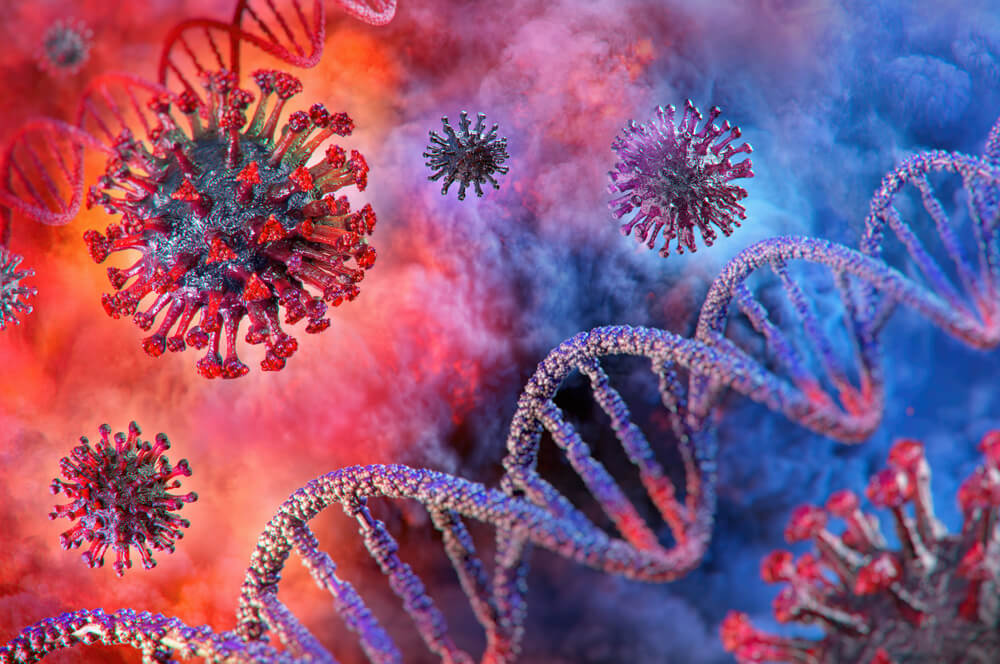Coronavirus mutated: a new strain is much more contagious than previous ones
According to a new study conducted by scientists from the Los Alamos National Laboratory, the new strain of coronavirus has become dominant worldwide and appears to be more contagious than the versions that spread during the early days of the COVID-19 pandemic. Writes about it SFGate.

Photo: Shutterstock
Scientists write that a new strain appeared in February in Europe, quickly migrated to the east coast of the United States, and has been the dominant strain worldwide since mid-March.
The report notes that in addition to faster distribution, it can make people vulnerable to reinfection.
The 33-page report was published on BioRxiv, a website that researchers use to share their work before it is peer-reviewed in order to expedite collaboration with scientists working on vaccines or COVID-19 drugs. This study was largely based on the genetic sequence of earlier strains and may be ineffective against the new one.
The mutation identified in the new report affects the now notorious bursts of coronavirus, which allow it to penetrate the human respiratory cells. The authors of the report stated that they felt the “urgent need for early warning” so that vaccines and drugs being developed around the world would be effective against the mutated strain.
Wherever the new strain appeared, it quickly infected much more people than the earlier strains that appeared in China, and within a few weeks, according to the report, it was the only strain common in some countries. The dominance of the new strain over its predecessors suggests that it is more contagious, although there is no explanation for this yet.
The coronavirus, known to scientists as SARS-CoV-2, has infected more than 3,5 million people worldwide and has caused more than 250 deaths since its discovery in late 000.
On the subject: Scientists first created an antibody that neutralizes coronavirus in human cells
The report was based on a computational analysis of more than 6000 coronavirus sequences from around the world collected by the Global Influenza Data Exchange Initiative, a public-private organization in Germany.
A team from Los Alamos, supported by scientists from Duke University and the University of Sheffield in England, identified 14 mutations. These mutations occurred among nearly 30 RNA base pairs, which other scientists say make up the coronavirus genome. The authors of the report focused on a mutation called D000G, which is responsible for changing outbreaks of the virus.
“This story is concerning because we see a mutated form of the virus emerging very quickly and becoming the dominant form,” study leader Bette Korber, a computational biologist at Los Alamos, wrote on her Facebook page. “When a virus with this mutation enters a community, it quickly begins to create a local epidemic, so it is more contagious.”
“This is difficult news,” Korber wrote, “but please do not be disappointed. Our team at LANL was only able to document the mutation and its impact on transmission thanks to the enormous global effort of scientists and experimental groups studying the virus.”
Corber, a graduate of Cal State Long Beach, who received her Ph.D. in chemistry from Caltech, joined the laboratory in 1990 and focused most of her work on the HIV vaccine. In 2004, she received the Ernest Orlando Lawrence Award, the highest recognition from the US Department of Energy for her scientific achievements. She contributed part of a financial prize to create a shelter for young AIDS victims in South Africa.
The report provides regional data on when the new strain of the virus first appeared, and how long it took for it to become dominant.
Italy was one of the first countries where the new virus emerged in the last week of February, almost simultaneously with the emergence of the original strain. Washington was one of the first states to encounter the original strain in late February, but by March 15, the mutated strain was already dominant. The original virus appeared in New York around March 15, and a few days later the mutant strain “took over.”
Scientists from large organizations working on vaccines or drugs have said they have their hopes in the initial evidence that the virus is stable and unlikely to mutate like the flu virus does, requiring a new vaccine every year. A report by scientists from Los Alamos may refute this assumption.
On the subject: 13 inspiring stories of good deeds in the era of the coronavirus
The study says the virus could undergo further mutations, even when research organizations produce the first medications and vaccines. Without risk, vaccine efficacy may be limited at this time. The authors of the study warned that if vaccines are developed based on the original version of the virus, they may be ineffective against the new strain.
“We cannot afford to remain at a standstill as we enter the vaccine and antibody testing phase,” Korber wrote on Facebook. “Please take heart in knowing that the global scientific community is engaged in this, and we are collaborating with each other in a way that I have never seen in 30 years as a scientist.”
David Montefiori, a scientist at Duke University who worked on the report, said he was the first to notice a mutation in the coronavirus that seems to make it more contagious.
Although the researchers still do not know the details of how the mutated virus behaves inside the body, it clearly does something that gives it an evolutionary advantage over its predecessor and contributes to its rapid spread. One scientist called this the "classic case of Darwinian evolution."
“The frequency of D614G is increasing at an alarming rate, indicating an advantage over the original Wuhan strain that allows for faster spread,” the study said.
It is still unknown whether this mutated virus can explain regional differences in how strongly COVID-19 affects different parts of the world.
In the United States, doctors began to study on their own whether new strains of the virus can explain the differences in methods of infection and death, said Alan Wu, a professor at the University of California at San Francisco, who runs clinical chemistry and toxicology laboratories.
Medical experts in recent weeks have suggested they have discovered at least two strains of the virus in the U.S., one common on the East Coast and the other on the West Coast, according to Wu.
On the subject: Rabies, influenza and smallpox: 12 of the deadliest viruses on Earth
"We're trying to identify the mutation," he said, noting that his hospital has only had a few deaths out of the hundreds of cases it has treated, which is "a very different picture than what we're seeing in New York."
A study in Los Alamos does not indicate that the new version of the virus is more deadly than the original. In people infected with a mutant strain, viral loads are higher. But the authors of a study from the University of Sheffield found that among the local sample of 447 patients, hospitalization rates were approximately the same for people infected with a particular version of the virus.
Even if the new strain is no more dangerous than others, it can still complicate efforts to control the pandemic. This would be a problem if the mutation makes the virus so different from earlier strains that people who are immune to them will not be protected from the new version.
If this is true, it can make "people susceptible to reinfection," the authors of the study write.
It is possible that the mutation will somehow change the structure of the virus, which will help him not to touch the immune system, said Montefiori, who has been working on an HIV vaccine for 30 years.
Read also on ForumDaily:
Scientists first created an antibody that neutralizes coronavirus in human cells
Smartphones will warn of the risk of coronavirus infection: how it works
13 inspiring stories of good deeds in the era of the coronavirus
COVID-19 - cause of death or associated disease: response from pathologists
Subscribe to ForumDaily on Google NewsDo you want more important and interesting news about life in the USA and immigration to America? — support us donate! Also subscribe to our page Facebook. Select the “Priority in display” option and read us first. Also, don't forget to subscribe to our РєР ° РЅР ° Р »РІ Telegram and Instagram- there is a lot of interesting things there. And join thousands of readers ForumDaily New York — there you will find a lot of interesting and positive information about life in the metropolis.











